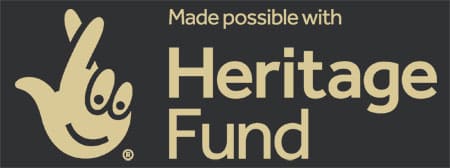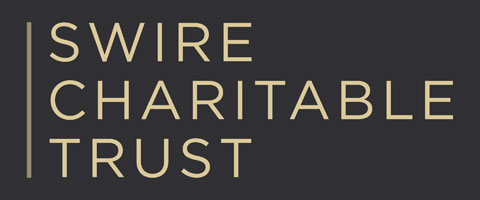Early fairground art styles featured intricate wood carvings, painted banners and exotic jungle and animal scenery. With limited access to books or media and foreign travel beyond the means of most, a painting at the fairground was probably your best chance to encounter a lion, giraffe or polar bear!
Gilding is an important feature of fairground artwork, with genuine gold leaf being used in early styles; later the use of coloured glazes painted over aluminium leaf became popular, amber yellow giving an impression of real gold, though much cheaper! These glazes were christened “Flamboyants” and feature heavily in fairground art.
The 1930s saw faster, lighter rides appear in fairgrounds, which often featured more uniform Art Deco “jazz” patterns. These could be quickly produced by lessskilled painters working to the designs of a head artist.
After the Second World War booming economic conditions led to showmen increasing the size and grandeur of their equipment, which of course needed new artwork to reflect the culture and fashion of the time, with space travel being a particular favourite.
The 1970s and 80s saw changing tastes with many new rides featuring spectacular airbrushed paintings, often depicting film and music stars, fast cars or sporting heroes.
Today many artists focus on recreating older artwork styles whilst others continue to push boundaries creating new themes, with Showmen always looking to keep their attractions ahead of the competition.
Skills handed down through the generations
Amongst the earliest names known to paint regularly for the fairgrounds was William Spilsbury of Bristol, who worked for local showmen painting animal portraits and jungle scenery, a popular fairground theme. In the early 1900s Spilsbury took on an assistant, Albert Howell, who excelled at animal and jungle scenes as well as painted show banners. Upon Spilsbury’s death in 1907, Albert began working freelance, placing an advert in World’s Fair reading “A.S.Howell, Artist and Decorator, high class painting and decoration for all kinds of exhibitions”.
After a few years and with a growing family to support, Albert accepted a job with George Orton, so moving to Burton on Trent and gaining a steady income. Here, Albert joined a team of painters led by the talented artist Herbert Darby, who was responsible for the designs of the firm’s spectacular Scenic Railway switchbacks with themes of ancient mythology, jungle scenery and the animal kingdom.
By 1930 Albert Howell’s son Sidney had joined the now Orton and Spooner paint shop and he succeeded Darby as head artist in 1933. Sid was an exceptionally gifted artist and had a keen eye for the contemporary designs of the 1930s, creating Art Deco inspired “jazz patterns” which came to decorate most of Orton’s rides of the time. Sid was a brilliant sign writer, creating many ride fronts with his characteristic letterforms and was equally skilled in scenic art in a wide range of subjects.
The other great ride manufacturer of the 1930s was R.J. Lakin of Streatham, where there was always a busy paint shop. Robert Lakin had worked at Orton and Spooner in the 20s demonstrating the firm’s equipment but decided to set up his own company in London.
Painter William Hall followed Lakin from Burton to London to establish a new paint shop but it was William’s son Edwin who came to prominence in the 1930s.
Edwin was talented in many styles and themes including jungle scenery, motorsports and chariot races. Also an excellent sign writer, Edwin developed his own letterforms in many styles.
Sitting outside of the paint shops of the major manufacturers of this period, the showman and artist Charles Duffield built and decorated games and side stalls in his own unique style of scrollwork and lettering. Duffield’s work often required many duplicate artworks, which he used a clever combination of hand painting and stencilling to create. In terms of output, Duffield might well be the most prolific painter mentioned here and happily a great deal of his work survives.
After the Second World War the larger manufacturers began moving away from fairground work, so the former Lakin painter Fred Fowle set up in business with Edwin Hall’s brother Billy.
An unassuming and methodical man, Fowle would become the best known of the fairground painters. Fowle was at first helped with design by Edwin Hall; typical patterns might feature winged wheels, ribbon scrollwork and lightning flashes.
By 1964 Fowle had set up on his own in Balham and he decorated dozens of rides and stalls over the next twenty years, developing his own style using aluminium leaf and flamboyant enamels, often inventing his own unique and stylised letterforms. In collaboration with Fowle a great many ghost trains and fun houses were painted by Roger Vinney, with scenes depicting monsters, ghosts, witches and usually a self-portrait!
As a master craftsman who was eager to teach, many helpers were taken on over the years working alongside Fowle and long-time assistant Len Huckle, with apprentice Mark Gill and Pete Tei becoming prominent artists in their own right during the 80s and 90s. Gill runs his paint shop near Sydney, Australia, catering for local showmen but is also known to travel back to the UK for special commissions. Tei, who works near Derby, is known for his work under the name “Tate Decor” and particularly his modern twist on Fowle’s techniques, nicknamed Tateworm owing to its swirling lines and vibrant colours.
There are of course many more artists within the fairground community who have practised and handed down their skills over many years, all contributing to this unique art form.
Historical Details provided by The Fairground Heritage Trust https://www.fairground-heritage.org.uk






